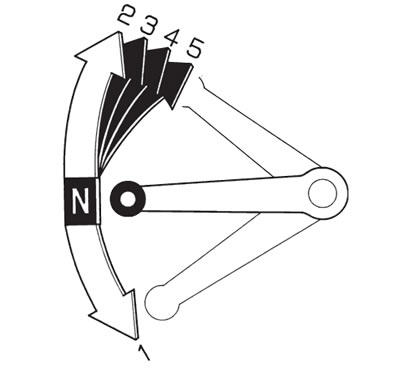Make sure you know how the side stop mechanism works. (Read the Maintenance Schedule Here and explanations regarding the side stop, Here).
Make sure that flammable materials, such as dry grass and leaves, do not come into contact with the motorcycle exhaust system while the motorcycle is riding, idling, or parked.
1. After the engine has warmed up, the motorcycle is ready to ride.
2. While the engine is idling, press the clutch lever and press the shift pedal to engage 1st (lowest) transfer.
3. Slowly release the clutch lever and at the same time gradually increase the engine speed by opening the throttle valve. The combination of simultaneously opening the throttle and releasing the clutch will ensure smooth starting and acceleration.
4. When the motorcycle accelerates to a moderate speed, close the throttle, press the clutch lever and engage 2nd gear by moving the shift pedal up. This operation is repeated sequentially when moving to the 3rd, 4th and 5th (higher) transfers.
5. Coordinate the throttle and brakes to reduce speed smoothly.
6. The front and rear brakes should be used simultaneously, without applying excessive braking, so as not to lock the wheels, otherwise the braking intensity will decrease and control of the motorcycle will be difficult.

Braking
Your motorcycle is equipped with a combined braking system. Pressing the brake lever engages the front wheel disc brake. Pressing the rear brake pedal activates the rear brake and partially the front brake. To ensure full braking performance, use the lever and pedal simultaneously, just as you would with a traditional brake system.
To ensure proper braking, apply the front and rear brakes simultaneously and shift to lower gears as your speed decreases. For maximum braking performance, close the throttle, apply firm pressure to the brake lever and pedal, and depress the clutch before the motorcycle comes to a complete stop to prevent engine stalling.
Important safety information:
- If you operate only the lever or only the brake pedal, the braking intensity will decrease.
- Braking too hard can cause the wheel to lock, making it difficult to control the motorcycle.
- If possible, slow down or brake before entering the turn.
- Closing the throttle or braking in a corner can cause the wheel to skid. When skidding, controlling the motorcycle becomes significantly more difficult.
- When driving on wet surfaces, in rain or on loose surfaces, maneuverability and braking properties deteriorate significantly. In these driving conditions, all your actions should not be abrupt, but smooth. Sudden acceleration, braking, or sharp turns can result in loss of control. For your safety, exercise extreme caution when braking, accelerating and turning.
- When driving down long or steep inclines, use engine braking and periodic braking on both wheels. Prolonged braking can lead to overheating of the brake mechanisms, which will reduce the intensity of braking.
- If you keep your foot on the brake pedal and your hand on the brake lever while driving, the brake light may be activated, which will confuse other drivers.
- It can also cause the brakes to overheat, reducing braking performance.
